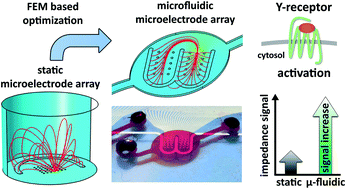Our official English website, www.x-mol.net, welcomes your
feedback! (Note: you will need to create a separate account there.)
A novel microfluidic microelectrode chip for a significantly enhanced monitoring of NPY-receptor activation in live mode
Lab on a Chip ( IF 6.1 ) Pub Date : 2017-10-31 00:00:00 , DOI: 10.1039/c7lc00754j Franziska D. Zitzmann 1, 2, 3, 4, 5 , Heinz-Georg Jahnke 1, 2, 3, 4, 5 , Felix Nitschke 1, 2, 3, 4, 5 , Annette G. Beck-Sickinger 3, 4, 5, 6, 7 , Bernd Abel 5, 8, 9 , Detlev Belder 3, 5, 10, 11 , Andrea A. Robitzki 1, 2, 3, 4, 5
Lab on a Chip ( IF 6.1 ) Pub Date : 2017-10-31 00:00:00 , DOI: 10.1039/c7lc00754j Franziska D. Zitzmann 1, 2, 3, 4, 5 , Heinz-Georg Jahnke 1, 2, 3, 4, 5 , Felix Nitschke 1, 2, 3, 4, 5 , Annette G. Beck-Sickinger 3, 4, 5, 6, 7 , Bernd Abel 5, 8, 9 , Detlev Belder 3, 5, 10, 11 , Andrea A. Robitzki 1, 2, 3, 4, 5
Affiliation

|
Lab-on-a-chip devices that combine, e.g. chemical synthesis with integrated on-chip analytics and multi-compartment organ-on-a-chip approaches, are a fast and attractive evolving research area. While integration of appropriate cell models in microfluidic setups for monitoring the biological activity of synthesis products or test compounds is already in focus, the integration of label-free bioelectronic analysis techniques is still poorly realized. In this context, we investigated the capabilities of impedance spectroscopy as a non-destructive real-time monitoring technique for adherent cell models in a microfluidic setup. While an initial adaptation of a microelectrode array (MEA) layout from a static setup revealed clear restrictions in the application of impedance spectroscopy in a microfluidic chip, we could demonstrate the advantage of a FEM simulation based rational MEA layout optimization for an optimum electrical field distribution within microfluidic structures. Furthermore, FEM simulation based analysis of shear stress and time-dependent test compound distribution led to identification of an optimal flow rate. Based on the simulation derived optimized microfluidic MEA, comparable impedance spectra characteristics were achieved for HEK293A cells cultured under microfluidic and static conditions. Furthermore, HEK293A cells expressing Y1 receptors were used to successfully demonstrate the capabilities of impedimetric monitoring of cellular alterations in the microfluidic setup. More strikingly, the maximum impedimetric signal for the receptor activation was significantly increased by a factor of 2.8. Detailed investigations of cell morphology and motility led to the conclusion that cultivation under microfluidic conditions could lead to an extended and stabilized cell–electrode interface.
中文翻译:

新型微流控微电极芯片,用于显着增强实时模式下NPY受体激活的监测
结合了例如芯片实验室的设备具有集成的片上分析和多室片上器官方法的化学合成是一个快速且有吸引力的研究领域。尽管在微流体装置中集成合适的细胞模型以监测合成产物或测试化合物的生物活性已经成为人们的关注焦点,但无标记生物电子分析技术的集成仍然很难实现。在这种情况下,我们研究了阻抗谱作为微流控装置中贴壁细胞模型的非破坏性实时监测技术的能力。虽然从静态设置对微电极阵列(MEA)布局进行了初步调整,发现在微流控芯片中阻抗谱的应用存在明显的局限性,我们可以证明基于FEM仿真的合理MEA布局优化在微流体结构内实现最佳电场分布的优势。此外,基于有限元模拟的剪应力分析和与时间有关的试验化合物分布可确定最佳流速。基于仿真得出的优化微流体MEA,在微流体和静态条件下培养的HEK293A细胞具有可比的阻抗谱特性。此外,表达Y1受体的HEK293A细胞用于成功证明微流控设置中的细胞变化的阻抗监测功能。更惊人的是,受体激活的最大阻抗信号显着增加了2.8倍。
更新日期:2017-11-09
中文翻译:

新型微流控微电极芯片,用于显着增强实时模式下NPY受体激活的监测
结合了例如芯片实验室的设备具有集成的片上分析和多室片上器官方法的化学合成是一个快速且有吸引力的研究领域。尽管在微流体装置中集成合适的细胞模型以监测合成产物或测试化合物的生物活性已经成为人们的关注焦点,但无标记生物电子分析技术的集成仍然很难实现。在这种情况下,我们研究了阻抗谱作为微流控装置中贴壁细胞模型的非破坏性实时监测技术的能力。虽然从静态设置对微电极阵列(MEA)布局进行了初步调整,发现在微流控芯片中阻抗谱的应用存在明显的局限性,我们可以证明基于FEM仿真的合理MEA布局优化在微流体结构内实现最佳电场分布的优势。此外,基于有限元模拟的剪应力分析和与时间有关的试验化合物分布可确定最佳流速。基于仿真得出的优化微流体MEA,在微流体和静态条件下培养的HEK293A细胞具有可比的阻抗谱特性。此外,表达Y1受体的HEK293A细胞用于成功证明微流控设置中的细胞变化的阻抗监测功能。更惊人的是,受体激活的最大阻抗信号显着增加了2.8倍。











































 京公网安备 11010802027423号
京公网安备 11010802027423号